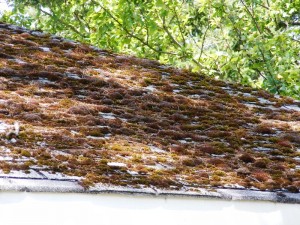By Brian Rader, San Juan County Pollution Prevention Specialist
Shady, moist, and slightly acidic. It seems to grow everywhere in San Juan County, but flourishes in areas that are shady, moist, and slightly acidic.
On roofs, moss holds moisture which can lead to leaks and serious damage to your home. On decks, sidewalks, or driveways, moss can create slipping hazards, and some people don’t like the way it looks in yards.
If we want to control this stuff, what are our options? How can we get rid of moss, without creating poisonous runoff from roofs, driveways and yards that ultimately ends up in our drinking water, streams or in the sea?
First, how can we prevent the moss invasion before it starts? The easy answer (please try not to laugh as you read this): avoid creating conditions that are favorable for growth (shady, moist, slightly acidic). I think the whole county is shady and moist. I’m sure some parts are slightly acidic, too! Here are some practical and effective strategies to minimize mossy habitat:
- Add sunlight and increase air circulation. Trim back trees and other vegetation that are touching or shading areas where moss growth is a concern.
- Keep your roof clean. Plant debris and branches on your roof can contribute to that shady and moist situation that we are trying to avoid. Be kind to your roof when cleaning, though. Avoid pressure washing or using abrasives on a composition roof. A garden blower can be useful. And… be careful up there!
- Inspect often. Moss is easier to control if you catch it early. More on control later.
- Re-roofing? Consider a metal roof. Moss sticks best to cedar shake, less so to composition shingles.
Ok, so what if you already have a moss problem? How can you get rid of this stuff safely? If your roof has a large colony of healthy moss, your best options are as follows:
- Inspect your roof to see if the roofing material is in good enough shape to withstand moss control measures. You may want to have a roofing expert help you with this step.
- Carefully remove as much moss as you can using physical measures:
- For composition shingles, use a garden blower or soft broom.
- For cedar shake you can be more aggressive and use a garden rake, brush or broom.
- If you can… stop here.
- Last, if you have removed everything you possibly can using physical removal, apply the smallest amount possible of the least toxic herbicide to any moss that is left.
A word on “least-toxic” moss killers: There is no truly safe pesticide. They all have unintended consequences (meaning they tend to harm or kill things we don’t intend them to). All moss killers, including those based on soap products like “Safer”, are toxic to aquatic organisms. Products containing metals, like zinc, are also potentially toxic to fish and other aquatic life. It’s all about how you control the runoff water.
Where does your runoff water go? Your location matters!
- If you are in Town, the water that runs off your home or business roof may take the storm drain expressway to the harbor, where it may kill fish and other aquatic organisms. Can you redirect this water to a grassy area where it can infiltrate through the soil?
- If you are on the shoreline, you have a similar problem. Can you keep the runoff water from running into the sea?
- If you are inland, and not near a stream or wetland, you still want to be careful. Too much of the wrong chemical can cause problems in gardens and yards.
Now for the big question… what are the “least-toxic” moss killers? The Washington Toxics Coalition (in their fact sheet on moss control which you can download here: https://watoxics.org/files/moss.pdf/view?searchterm=moss) lists the following products (active ingredients in parentheses):
- Safer Moss & Algae Killer and Surface Cleaner II (potassium salts of fatty acids)
- Bayer Advanced 2-in-1 Moss & Algae Killer (potassium salts of fatty acids)
- Worry Free Moss & Algae Control (sodium lauryl sulfate, citric acid, acetic acid)
- St. Gabriel Laboratories Moss Killer (clove oil, sodium lauryl sulfate, acetic acid, citric acid, mineral oil, lecithin)
Note that the last two products contain sodium lauryl sulfate, which is a detergent ingredient that we really want to keep out of surface water!
Local researcher Russel Barsh has had good luck controlling moss using a concentrated version of hydrogen peroxide (25% to 30%, instead of the 3% sold as a disinfectant in drugstores) to kill moss. Hydrogen peroxide is a strong oxidizer that is only really hazardous at the point of contact. Within minutes, it will oxidize into water. That said, as a strong oxidizer, extreme care needs to be used when applying hydrogen peroxide: avoid contact, avoid vapors, avoid ingesting!
The bottom line: Try physical removal first and avoid using pesticides. Remember these products are NOT non-toxic. They do have unintended consequences. They are all toxic to aquatic organisms. Be careful. Watch the weather. Look downhill. Control the runoff water.
**If you are reading theOrcasonian for free, thank your fellow islanders. If you would like to support theOrcasonian CLICK HERE to set your modestly-priced, voluntary subscription. Otherwise, no worries; we’re happy to share with you.**









The cheapest, least-toxic method I know of is to dissolve baking soda in a bucket of water, and flood the mossy section of the roof, preferably after the bulk of the moss has been physically removed. This effect can last up to a couple years.